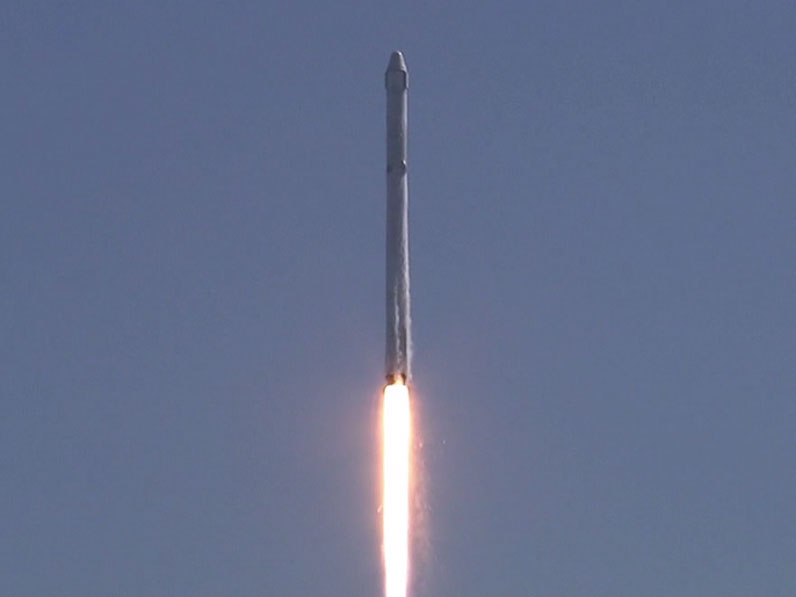Of Mice and Synthetic Muscle: Big Science On SpaceX Dragon Spaceship

SpaceX's Dragon cargo capsule is hauling a lot of science gear up to the International Space Station, including experiments for the orbiting outpost's first one-year crew.
The unmanned Dragon launched into space Tuesday (April 14) atop a SpaceX Falcon 9 rocket, which lifted off from Florida's Cape Canaveral Air Force Station. It is due to arrive at the space station at 7 a.m. EDT (1100 GMT) Friday, April 17. Astronauts will grapple the capsule using the station's huge robotic arm, then begin offloading its 4,300 lbs. (1,950 kilograms) of cargo.
Some of this equipment will help NASA examine the nature of eye problems that have plagued several astronauts on long-term missions. Scientists suspect these issues may be caused by an increased buildup of fluid in the head in microgravity conditions, but more study is needed to confirm the idea, said Marshall Porterfield, NASA's life and physical sciences division director. [SpaceX Launches Dragon to Space Station (Video)]
Other payloads aboard Dragon will support genetic comparisons between one-year mission crewmember Scott Kelly and his twin brother, Mark, who is being studied on Earth as a control. (Scott Kelly and fellow one-year crewmate Mikhail Kornienko of Russia arrived at the orbiting lab late last month.)
"It's allowing us to make a leap from [missions of] six months to a year and project out what we need to do to protect humans over longer periods of time," Porterfield said during a prelaunch news conference Sunday (April 12).
Bone studies
Dragon's cargo also includes an Italian-made "ISSpresso" space coffee machine, 20 mice and many other items.
The rodents are flying as part of an experiment that will look at how extended periods in microgravity affect bones. Space station crewmembers will X-ray the mice and dissect them, NASA officials said.
Breaking space news, the latest updates on rocket launches, skywatching events and more!
Dragon was originally supposed to fly parts to change a docking port to prepare the orbiting lab for commercial vehicles, but that payload was shifted to a later flight to give astronauts more time for science, said Kirt Costello, deputy chief scientist for the International Space Station.
"This [rodent] investigation requires a significant amount of crew time," Costello said during another news conference on Sunday (April 13) "We did have plans to fly a payload in the trunk; that payload would have taken a significant amount of time to install on orbit as our international docking adaptor system."
Drugs and muscle
Dragon's cargo also includes experiments designed to improve medicine and robotics. One is a crystal-growth study from Paul Reichert, a scientist at Merck Research Laboratories in New Jersey who previously flew protein-growth experiments on 11 space shuttle missions.
Reichert said he hopes his process will create larger and more uniform crystals for a class of drugs called biologics. Many of these can only be delivered by IV at a hospital, increasing costs and stay time for patients. Reichert's aim is to make biologics that could be delivered by a simple injection, perhaps at home or at a doctor's office.
"That would have a significant impact on the ease of administration and the comfort of the patients," he said.
Dragon is also flying a synthetic muscle (an electroactive polymer) to the station, which will remain there for up to 80 days to test its resistance to radiation. The long-term aim of the project is to create robots with this synthetic muscle, but first investigators want to compare how well it performs compared to metal.
Follow Elizabeth Howell @howellspace, or Space.com @Spacedotcom. We're also on Facebook and Google+. Originally published on Space.com.
Join our Space Forums to keep talking space on the latest missions, night sky and more! And if you have a news tip, correction or comment, let us know at: community@space.com.

Elizabeth Howell (she/her), Ph.D., was a staff writer in the spaceflight channel between 2022 and 2024 specializing in Canadian space news. She was contributing writer for Space.com for 10 years from 2012 to 2024. Elizabeth's reporting includes multiple exclusives with the White House, leading world coverage about a lost-and-found space tomato on the International Space Station, witnessing five human spaceflight launches on two continents, flying parabolic, working inside a spacesuit, and participating in a simulated Mars mission. Her latest book, "Why Am I Taller?" (ECW Press, 2022) is co-written with astronaut Dave Williams.
